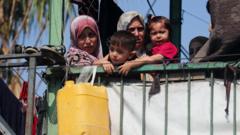Following a devastating earthquake in Tibet, rescue teams are grappling with extreme winter conditions while aiding the displaced and searching for survivors among the rubble.
Tibet Earthquake Displaces Thousands as Rescuers Battle Harsh Winter Conditions

Tibet Earthquake Displaces Thousands as Rescuers Battle Harsh Winter Conditions
A magnitude-7.1 earthquake hits Tibet, causing extensive damage and fatalities amid freezing weather, sparking urgent rescue missions.
In the wake of a powerful magnitude-7.1 earthquake that struck the Tibetan region near Nepal, rescue operations have been launched amid harsh winter conditions, with temperatures plummeting to minus 18 degrees Celsius (0 Fahrenheit). The quake, which occurred on Tuesday morning and centered in Dingri County, resulted in the destruction of over 3,000 homes and claimed at least 126 lives, with 188 additional injuries reported.
Rescue workers have faced significant challenges as they sift through debris to find survivors and assist tens of thousands of residents displaced by the disaster. Reports indicate that the quakes were followed by over 660 aftershocks, with some reaching magnitudes of 3.0, heightening the already precarious situation. Survivors and emergency personnel alike are coping with freezing temperatures, as they work to provide shelter and medical assistance in the wake of the tremors.
The relief effort has faced challenges amplified by the extreme weather, limiting the scope and speed of rescue missions. Aerial images from the affected area reveal frozen lake surfaces, and with low temperatures forecast for the next few days, rescuers are trying to work quickly to assist those in need. Much of Tibet is difficult to access, complicating rescue efforts further, especially given the region's political tensions and restrictions on independent foreign journalism.
In response to the situation, regional officials, led by Vice Premier Zhang Guoqing, have been visiting hospitals and temporary camps to oversee humanitarian efforts. Authorities have focused on delivering medical care and ensuring basic necessities like food and warmth to the affected population. More than 400 survivors have been rescued, and over 30,000 individuals have been relocated to safer areas.
Essential services, including electricity, are gradually returning in the surrounding towns and villages, with crews working to clear roads obstructed by debris. Images from the state broadcaster show soldiers laboring to remove rubble while offering aid to the survivors, who huddle in tents draped with insulated materials, attempting to shield themselves from the bitter cold.
The ongoing relief efforts continue to adapt as conditions evolve, illustrating the lamentable impact of nature's violent forces against the backdrop of an already vulnerable region.




















